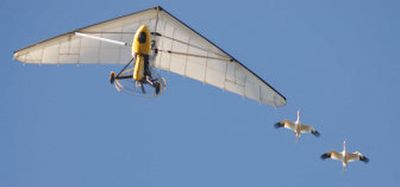Whooping cranes glide to higher population

AUSTWELL, Texas – One of the most-beloved groups of winter Texans is back – in the largest numbers in a century and with a record 45 youngsters in tow, including an even rarer seven pairs of twins.
They flew 2,400 miles from Canada’s Northwest Territories and can be seen munching on blue crabs and bright red-orange wolfberries in the marshes of the Aransas National Wildlife Refuge.
The whooping crane, the tallest bird in North America whose numbers had dwindled to fewer than 20 in 1941, not only is back from the brink of extinction but also is thriving – a comeback story, federal wildlife officials say, that illustrates how a coordinated conservation effort can save a species.
“The whooping crane continues to mirror the success of endangered-species recovery when man sets his mind to it,” said Tom Stehn, national whooping crane coordinator for the U.S. Fish and Wildlife Service. “We have come a long way, but we do have a long, long way to go.”
This year, the nation’s only natural wild population of whooping cranes reached a milestone. Stehn’s mid-December census of the migratory crane flock at the wildlife refuge, where he is based, numbered 237.
Combined with the number of birds in captivity in three special flocks raised for reintroduction into the wild and those in zoos, the crane population now totals 518. This is the first time in more than a century that whooping cranes have numbered more than 500.
Recovery efforts date to 1938, a year after the federal government established the Aransas National Wildlife Refuge along the south Texas coast. The salt marsh was known to be the winter home of several species of migratory birds, including the majestic whooping crane, with its long, sinuous neck, height of 5 feet and wingspan of 7 feet.
The cranes numbered just more than 20 in the first census in 1938. By 1941, the migratory flock was down to 15 largely because of shooting, the conversion of grasslands to agriculture and the draining of wetlands.
“This species was virtually four nesting females away from extinction, and that’s why this is so significant,” Stehn said. “It was just such a close call, such an incredibly close call.”
The crane’s breeding grounds were unknown until 1954 when a fire crew flying over Wood Buffalo National Park in the Northwest Territories accidentally discovered the migratory flock.
In the United States, the whooping crane was listed as a threatened species in 1968 and moved to the endangered list two years later, prompting a series of efforts to increase the flock’s size.
From the mid-1970s to the late 1980s, whooping crane eggs were placed in sandhill crane nests in Idaho so the sandhill cranes could teach the whoopers how to survive in the wild, when to migrate and where to winter. But that whooping crane flock never paired or reproduced, and the last whooper in the Rocky Mountains died in 2002.
U.S. scientists developed a technique in the 1980s for raising whoopers in captivity by using crane handlers – humans dressed in costumes that resemble cranes – to raise chicks in isolation from actual human contact so they would grow up to be wild. Starting in 1993, many of those captive cranes have been released yearly in central Florida, where they have stayed because they never learned how to migrate – behavior that normally would be passed on by their parents.
In 2001, the Whooping Crane Eastern Partnership – an American-Canadian partnership of governments, nonprofit organizations, citizens and corporations – developed a method to teach captive-raised whoopers how to migrate so they could be introduced into the wild. Since then, young cranes have been led in migration every fall by gliders flying from the Necedah National Wildlife Refuge in Wisconsin to the Chassahowitzka National Wildlife Refuge in Florida, 1,200 miles away. The cranes return on their own in the spring.